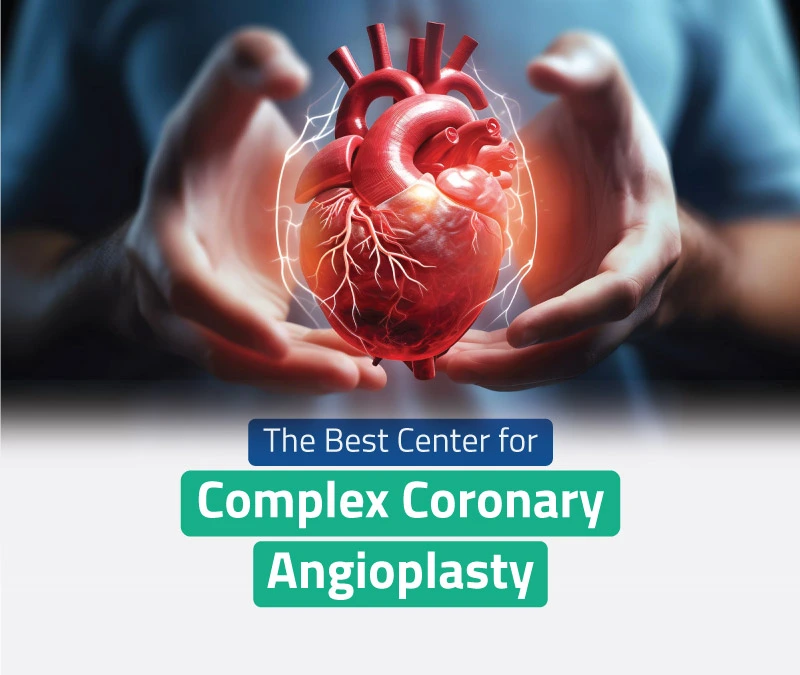Coronary angioplasty involves dilating a balloon at the site of the blockage to enlarge the passage for blood flow in the coronary arteries. Most of the time, a stent will need to be implanted as a scaffold to keep the artery open. A drug-eluting stent will deliver a drug locally to the vessel wall to prevent the blockage from coming back (restenosis). Primary angioplasty is done at the time of an acute heart attack as a life-saving procedure to open an artery blocked with blood clots.
Conditions treated in Complex Coronary Angioplasty
Significant Blockage or narrowing of the coronary artery due to fatty plaque deposition when medication and lifestyle changes do not improve angina.
Severe chest pain and acute heart attack
Extremely severe blockages
In tortuous vessels
Blockages are at the branching points or on the left main artery.
Reduced pumping of the heart
Other major co-existing diseases
Frail / elderly / malnourished patients
In conditions where coronary artery bypass surgery is not feasible due to major diseases of the lungs, liver, kidney, brain, etc, Or, if the patient is unwilling for a surgical procedure.
Advantages Of Coronary Angioplasty
Non-Surgical Treatment
The whole process could take 1-6 hours depending on the number of blocks and potential complication.
Be prepared for 2 days’ hospital stay, try to arrange transportation as you are not advised to drive on the following day of the procedure.
You will be able to return to normal life within one/two weeks, depending on the recovery.
About the procedure
Coronary Angioplasty is performed under local anesthesia usually. Sedation is not usually required. It is commonly done from a radial artery approach (wrist) or from a femoral artery approach (groin). A catheter is threaded over a wire till the concerned coronary artery is reached and selectively engaged. Dye injections are made under fluoroscopy to delineate the blockages. The blockage is crossed with a wire. A balloon is tracked over the wire and inflated at the site of the blockage. A stent (wire mesh, often coated with a drug) is then implanted at the site and fixed with balloon inflation. Further balloon dilatations may be needed to ensure that the correct expansion of the stent is reached and the blockage is totally relieved. After confirmation of good flows, the wires and catheters are removed. The sheath is removed when it can be safely done without excessive bleeding.
After the procedure
The expert cardiac team at Aster Medcity, Kochi will closely monitor your vital signs as well as your heart’s functioning. Cardiac drugs are optimized and the patient is made to walk. Diet and exercise advice are given at the time of discharge, along with a detailed summary listing the procedure, and the drugs that need to be continued. You will be able to return to normal life within one or two weeks. It is recommended to increase the fluid intake as it helps to remove the dye used during coronary angioplasty. Patients are also advised to avoid heavy exercise and the lifting of hefty objects.
General guidelines for patients preparing for Coronary angioplasty
Do NOT stop essential cardiac medicines, antihypertensives, medicines for blood sugar, etc
Avoid food and water intake before 3-4 hours of coronary angioplasty
Be prepared for an overnight hospital stay; try to arrange transportation as you are not advised to drive on the following day of the procedure.
FAQs
At Aster Hospitals we provide the highest quality of care and a transformative experience for all your healthcare needs. With our network of multi-speciality hospitals, specialised doctors, and world-class technology, we bring global standards of medical care to our patients.
What is Angioplasty?
Angioplasty is a minimally invasive procedure used to treat blockages / narrowing of blood vessels.
Why do I need Angiogram & Angioplasty?
An angiogram & angioplasty is suggested to a patient if you experience,
- Radiating pain in your chest, jaw, neck or arms
- Abnormal results of a of heart stress test, ECG
- Problems related to blood vessel
- Injury to your chest
- Problems with valves of your heart which may require surgical intervention.
Does Angioplasty hurt?
There is no significant pain except for the discomfort at the time of the needle puncturing the artery and again, at the time of removal of the sheath when pressure has to be applied at the site of puncture to prevent bleeding.
How long do you stay in hospital after Angioplasty?
Be prepared for 2 days’ hospital stay, try to arrange transportation as you are not advised to drive on the following day of the procedure.
How is life after Angioplasty?
Do follow a healthy diet and lifestyle to reduce the risk of developing block in your arteries again. It is recommended to start less intensive exercise such as walking on plain ground. Patient can gradually increase the intensity of the exercise. Regular drugs are needed lifelong including blood thinning antiplatelet drugs to prevent reblockage and blood clotting within the stents.
What is a stent in Angioplasty?
Stent is a small, metal mesh tube placed in blood vessels during angioplasty to act as a scaffold and to reduce the chances of developing blocks in the future.
How Angioplasty is performed?
A small balloon catheter is inflated at the site of the blockage in the coronary artery to remove the block and improve the blood flow to the heart.
How long does it take to complete Angioplasty procedure?
The whole process could take 1-4 hours depending on the number of blocks and potential complication.
How long does it take to recover from Angioplasty?
You will be able to return to normal life within one/two weeks, depending on the recovery.
How long will a heart stent last?
In most of the patients the stents will stay open forever, only 4-9% patients may have chance of narrowing occurring again.
It should be remembered that angioplasty/surgery, stents, etc tackle the existing blocks. Only some of the primary risk factors that caused the blockage can be treated/controlled. Hence, new blockages can occur again. A healthy diet and lifestyle with avoidance of smoking, good control of sugar/pressure/cholesterol are essential.










